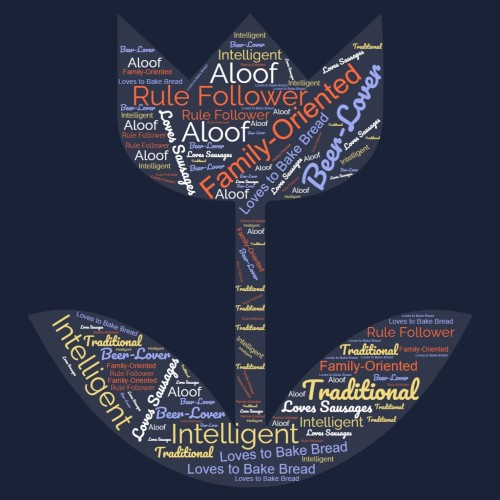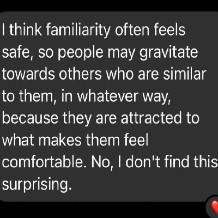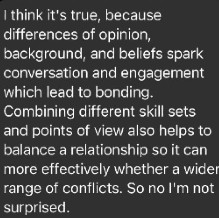Artifact 3:

Module 12’s activity on aggression was my favorite. It made me examine my feelings and thoughts about aggressive behavior. I think what I learned is aggression can take many shapes and forms. As someone who survived domestic violence, I think I rated many of the circumstances/situations in the assignment as aggressive, when others may not have. For instance, while many may not have rated the statement: “A tennis player smashes his racket after missing a volley,” as aggressive because the player did not harm anyone and they were simply frustrated with missing the volley. On the other hand, I believe the statement does depict aggression. While the player isn’t hurting anyone, they may be using their violent outburst to intimidate their opponent, which is a show of aggression. Perpetrators of domestic violence often use Intimidating behavior against their victims.
I also rated this statement as aggressive: Mr. X, a notorious gossip, speaks disparagingly of many people of his acquaintance. Aggressive behavior doesn’t have to be physical. In this example, gossiping and speaking disparagingly about people could damage their reputation, which perhaps is what Mr. X aims to do. Making comments about someone in order to harm their reputation and image is aggressive behavior. While this behavior doesn’t physically hurt the victim, it does harm them if their reputation is damaged or the victim is shunned from their social circles.
I think this assignment made me realize that many people will perceive aggression differently. I had my husband do the questionnaire with me. While many of his answers were the same as mine, he also had very different answers to some of the statements. What I find aggressive, someone else may not, and vice versa.
I chose the image above because it shows how aggressive behavior doesn’t necessarily have to be physical acts, it can be verbal too. I think it’s important to note that because many people don’t realise that there is power in their words.
Artifact 2:

Module eight was my favorite archive item because it challenges you to examine stereotypes. I think examining your own biases and stereotypes is extremely important for personal growth. I know when I was growing up with my step-father, he didn’t have a favorable outlook on anyone who was different than him. He often said terrible things out of fear, ignorance, and prejudice. When I was young, I was influenced by these biases. At the time, I didn’t know any better, and I wanted to connect with my step-father as he was the only father figure I had in my life at the time.
Things changed when I went to middle school. I went to a predominantly African-American school where I was exposed to people who were very different than me. I formed so many friendships that helped change my perspective on race. It was also in middle school that I really started understanding that my step-father was prejudiced because I couldn’t have my best friend (who was an African-American girl) stay the night. On the other hand, I couldn’t stay with her either because she lived in a nicer place than we did, and my step-father thought her family dealt in illegal activities to make them more well off than we were.
My step-father did start changing after an interracial family moved next door to us when I was in high school. He became close friends with the father, who was an African-American man.
I think when we’re faced with situations that make us examine our prejudice and bias, it challenges what we thought we knew about those people, especially if the situation shows us a different side of that group of people we’ve never seen before. It’s important that we put ourselves into different situations with different types of people to not only grow as people but to dismantle those deep-seated biases we may have learned from the generations before us.
The picture I chose for this module is the word-cloud. I am a second-generation American. My grandmother was born in Munich, Germany. These are some of the stereotypes I’ve heard, but also believe to be true of this particular group. We are very family-oriented and have lots of family traditions. Christmas Eve and Easter are always spent at my Grandmother’s house. On Christmas, we’d eat stollen and exchange gifts on Christmas Eve (because my Grandmother went to Mass on Christmas). We also can be aloof. I know that at times I can be aloof with people. My Grandmother is always aloof with those she doesn’t know. If asked where she is from by a stranger, she just tells them she’s from Europe and doesn’t elaborate. When I asked her why she did this, she’d tell me that when she came here in the 1950s, people were still very wary of the German people. So, she never disclosed her country of origin.
I think what I learned from this exercise is that the examination of biases should be an ongoing process. We are never done growing and learning.
Artifact 1:




Module three’s archive item is my favorite. It was an enjoyable assignment that allowed me to collaborate intellectually with several people. I posed questions that I wouldn’t ordinarily pose and received fascinating answers in return. It was interesting to see whether participants thought opposites or similarities attract.
All of the participants agreed with their statements. Initially, this surprised me until I examined the questions more closely. I learned the phrasing of a question matters. Each of the questions starts with the following statement: “social psychologists have found in their research…” I believe this statement influenced the participant’s answers because people are more inclined to agree with something that already has support information. I also think if the question had been phrased “do you believe opposites/similarities attract” then the answers would have been different.
I think this archive item taught me to examine questions closely, and it was an excellent example of how the wording of questions can affect their outcomes. For the visual artifact, I chose screenshots of the participant’s answers because they each took the time to give me a thoughtful response. As you can see, each of the participants agreed with their statements.